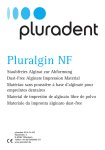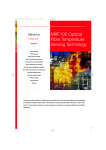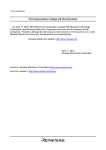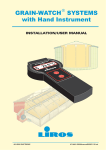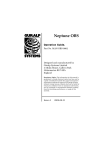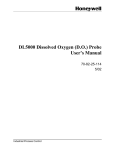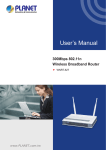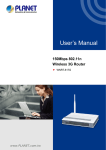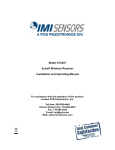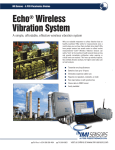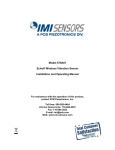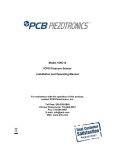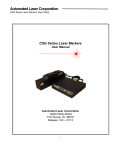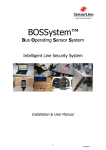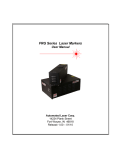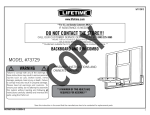Download Laser Safety Requirements Guidelines for Users of
Transcript
Laser Safety Requirements Guidelines for Users of Honeywell’s VCSEL Products zpFdF4pma4 zzda4"apm NOTICE This report contains a summary of publicly available information relevant to the use of laser products manufactured or sold by Honeywell. These are relatively low power lasers, and the precautions described herein pertain only to low power lasers. This document should not be used for determining safeguards for high power lasers. This information is based solely on Honeywell’s compilation of the applicable requirements and should not be considered a definitive analysis of these requirements or their impact on any one company’s goods or services. Because of the vast number of uses for these products and the changing nature of the requirements, Honeywell cannot give any assurances that the information contained herein is completely applicable or accurate. It remains the responsibility of the user to conduct an independent evaluation to assure that each application and use meet the requirements of all standards, regulations, codes, laws, and directives. INTRODUCTION Users of Honeywell’s VCSEL (Vertical Cavity Surface Emitting Laser) products need to understand the various standards and regulations pertaining to their use. Users of some VCSEL products will be required to establish internal safety programs to ensure employees are not exposed to dangerous levels of laser radiation. In addition, some manufacturers will be required to register their products with government agencies. The degree to which these requirements apply depends on the type of VCSEL product used and the manner in which it is used. The purpose of this report is to inform Honeywell’s customers of: • • • • What standards and regulations apply when using Honeywell’s VCSEL products. How to determine the extent to which these requirements apply. What is required to ensure that users are not exposed to unsafe levels of laser radiation. What is required to sell laser products in the different world markets. MICRO SWITCH Sensing and Control Laser Safety Requirements zpFdF4pma4zzda4"apm LASER DEFINITION Laser is an acronym which stands for Light Amplification by Stimulated Emission of Radiation. Light refers to electromagnetic energy with a wavelength in or near the visible portion of the spectrum. Honeywell’s VCSEL products emit energy in the near infrared (850 nm) portion of the spectrum. Energy is amplified to extremely high intensity through a process called stimulated emission. Radiation refers to energy transfer -- it does not mean that ionizing radiation is produced. Laser light is much like other forms of electromagnetic energy, but is has three characteristics that make it different from ordinary light: • • • Laser radiation is monochromatic -- it has a single color or wavelength. A laser beam is directional -- it is very well collimated and will travel a long distance with very little spread. A laser beam is coherent -- all waves of light energy emitted by a laser are in phase with each other. LASER HAZARDS There are a number of potential safety hazards when using a laser. The most common are damage to the eyes and skin. Honeywell VCSEL products cannot produce a beam capable of causing serious skin injury; however, without proper safeguards, they can cause eye damage. In a worst case exposure (direct exposure with the eye focused at a distance), a laser beam is focused by the eye in such a way that the 2 beam is concentrated 100,000 times before striking the retina. Therefore, a 10 milliwatt/cm laser beam 2 would result in a 1000 watt/cm exposure to the retina, more than enough to cause damage. LASER CLASSIFICATION Extensive research into the effects and hazards of laser radiation has allowed scientists to establish safe exposure limits for laser radiation. These limits are used to classify laser products so the user may know what precautions must be adhered to during use. Laser and laser product manufacturers must certify and label lasers according to the following four classifications: • Class 1 - Class 1 lasers are considered to be safe. This classification includes all lasers and laser systems that cannot emit levels of laser radiation above the exposure limit of the eye under any normal use of the product. A laser or laser system is also considered to be Class 1 if it contains a more powerful laser; but cannot, because of the design, ever emit radiation above the exposure limit of the eye. This is extremely desirable because the user need not take any precautions. Furthermore, if a Class 1 laser product is assembled into another system, the manufacturer does not need to register its product (provided the supplier has certified and registered the laser). This is the case for many Honeywell VCSEL modules. Although they contain a more powerful laser, it is contained within the assembly and cannot emit hazardous amounts of radiation. • Class 2 - Class 2 lasers are low power, visible lasers that pose little danger because a person’s natural aversion to bright light will protect the eye before any damage can occur. Examples of a Class 2 laser include a 0.5 milliwatt laboratory laser for schools or a hand-held bar code reader. Honeywell - MICRO SWITCH does not manufacture any Class 2 lasers. • Class 3 - Class 3 lasers are divided into two subgroups, Class 3A and Class 3B. Class 3A lasers are visible lasers whose output power exceeds Class 2 limits, but are less than 5 milliwatts. Most laser pointers are Class 3A. Class 3B lasers have visible output power from between 5 milliwatts and 0.5 watt. In addition, all Class 3 lasers that emit invisible radiation are considered Class 3B. Honeywell VCSEL components fall into this category. Direct or specular reflection viewing of Class 3 lasers can cause serious eye damage, and precautions to ensure safe usage must be followed. 2 Honeywell • MICRO SWITCH Sensing and Control For application help: call 1-800-367-6786 Laser Safety Requirements • zpFdF4pma4zzda4"apm Class 4 - Class 4 lasers are the most powerful group of lasers. Both eye and skin injuries are possible from not only direct viewing, but also by diffuse reflections. The greatest number of control measures are required to use these lasers safely. Honeywell MICRO SWITCH does not manufacture any Class 4 lasers. USER SAFETY STANDARDS United States - The primary standard for the safe use of lasers in the United States is ANSI Z136.1. This standard gives detailed instructions for the classification determination process and the requirements for using lasers safely. Because Honeywell certifies the classification of all its laser products, users are not required to perform any measurements -- they simply use the Honeywell classification for determining what level of precautions are needed. For users of Honeywell’s Class 1 modules, no requirements apply; but, for those using the Class 3B laser components, the standard should be used. The ANSI standard requires users of Class 3B and 4 lasers to designate a Laser Safety Officer who is responsible for identifying and implementing the required safeguards. These include, but are not limited to, controlling the area in which the lasers are operated, enclosing the beam path wherever feasible, providing protective equipment, and designing engineering controls that prevent unwanted emissions. The Occupational Health and Safety Administration (OSHA) uses ANSI Z136.1 (in conjunction with PUB 8-1.7 and Chapter 17) in determining whether a company's safety procedures are adequate. It is important to note that some states (New York, Texas, Florida and Arizona) also have requirements for users of lasers. European Union - The International Standard IEC 825-1, Safety of Laser Products - Equipment Classification, Requirements and User’s Guide, provides not only direction on how to safely use lasers, but also specifies the requirements for the laser manufacturer. While the precise methods for hazard calculations and the resulting requirements vary slightly between IEC 825-1 and ANSI Z136.1, both standards give detailed procedures for establishing a safe workplace. Users of a certified Class 1 laser product are not required to take any special precautions. Like ANSI Z136.1, IEC 825-1 provides clear direction for what is required when using a Class 3 or 4 laser. It requires users to provide engineering and administrative controls. These include safety interlocks, key control/beam stops, warning signs, eye protection and training (see Section Three of IEC 825-1, User’s Guide) whenever access to Class 3B and Class 4 laser energy is possible. Other Countries - While ANSI Z136.1 and IEC 825-1 are the two most common Laser Safety Standards, many other countries have their own safety requirements, or use one of these two standards (usually IEC 825-1). Users outside North America and Europe should determine what local safety standards are applicable before using a laser or laser product. MANUFACTURER STANDARDS United States - In the United States, manufacturers of lasers and laser products are regulated by the Food and Drug Administration’s Center for Devices and Radiological Health (CDRH). The requirements for laser manufacturers are set forth in the Code of Federal Regulations (CFR) Title 21. The requirements for reporting to the CDRH are listed in 21 CFR §1002 and the laser performance requirements are given in 21 CFR §1040. If a manufacturer is incorporating one of Honeywell’s Class 1 laser products into a product, no requirements apply either to the manufacturer or the customer. For application help: call 1-800-367-6786 Honeywell • MICRO SWITCH Sensing and Control 3 Laser Safety Requirements zpFdF4pma4zzda4"apm However, if a manufacturer incorporates one of Honeywell’s Class 3B laser components into a product, the regulations must be followed. In this case, the manufacturer may take either of two approaches. The manufacturer may design the product/system incorporating the laser in such a way that during its intended use and servicing, the laser emission is always below hazardous levels. This would now be a Class 1 laser product, and the end user would then not be required to implement the safety requirements of ANSI Z136. In this case, only the reporting requirements defined below are required. If the component is to be installed in an application in which there is no access to laser energy during operation or routine maintenance, but the laser energy could be accessible during service, 21 CFR §1040 requires only warning labels and precautions in the user manual. If the product cannot be designed in such a way that hazardous emissions during operation are not eliminated, the performance requirements of 21 CFR §1040 apply. This includes ensuring the product has a protective housing, safety interlocks (if necessary), a remote interlock connector, key control, an emission indicator, a beam attenuator, safe operating controls and viewing optics (if applicable). In addition, regulations require warning labels and user manuals with instructions for safe use. The reporting requirements of 21 CFR §1002 apply to all products that incorporate a Class 3B laser component. These include filing an initial Product Report, a Supplemental Report for any model or model family changes, an Annual Report, and, in the case of an accident, an Accidental Radiation Occurrence (ARO) Report. The initial Product Report describes the product and its functions, how the product complies, its labels and manuals, and manufacturing and quality control procedures. The Annual Report records sales and distribution details for the preceding year. In the event of a laser accident, the CDRH should be contacted so that an ARO Report can be prepared. A series of required guidelines from the CDRH is also available for the preparation of these reports. 21 CFR §1002 also requires retention of certain records for five years. These records include the distribution of products, quality control records, and all correspondence relative to the laser safety of the product. European Union - The European Union, through the European Committee for Electrotechnical Standardization (CENELEC), has adopted European Norm EN 60825-1. This standard consists of IEC 825-1, plus a section which each country may modify according to national requirements. This standard is a requirement in several countries and is effectively required in many others. Honeywell maintains certification of all its Class 1 laser products through independent Nationally Recognized Testing Laboratories (NRTL). For users of Honeywell’s Class 1 laser products, this means that no additional testing is required by the user, and that no user or manufacturer requirements of IEC 825-1 apply. If a manufacturer incorporates one of Honeywell’s Class 3B laser components into a product, the manufacturer may take either of two approaches. The manufacturer may design the product/system incorporating the laser in such a way that during its intended use and servicing, the laser emission is always below hazardous levels. This would now be a Class 1 laser product, and the end user would then not be required to implement the user requirements of IEC 825-1, section 3. Only the manufacturer would be subject to the user requirements. It is the responsibility of the manufacturer to demonstrate that the laser product/system cannot emit hazardous levels of laser radiation. 4 Honeywell • MICRO SWITCH Sensing and Control For application help: call 1-800-367-6786 Laser Safety Requirements zpFdF4pma4zzda4"apm If the product cannot be designed in such a way that hazardous emissions during operation are not eliminated, the manufacturing requirements apply. This includes ensuring the product has a protective housing, safety interlocks, a remote interlock connector, key control, an emission indicator, a beam attenuator, safe operating controls/view optics, and a scanning safeguard. In addition, the specification requires warning labels and user manuals with instructions for safe use. European users should also verify that all national standards are met. These can include reporting requirements and labeling in languages other than specified in IEC 825-1 and EN 60825-1. Other Countries - Manufacturers in other countries should review local regulations to determine what regulations and requirements apply. It should be remembered, however, that to sell in many world markets, the requirements of that market apply, regardless of where the product was manufactured. SOURCES OF ADDITIONAL INFORMATION American National Standards Institute 11 West 42nd Street New York, NY 10036 (212) 642-4900 Laser Institute of America 12424 Research Parkway #125 Orlando, FL 32826 (407) 380-1553 Center for Devices and Radiological Health 2098 Gaither Road Rockville MD 20850 (301) 594-4654 Rockwell Laser Industries P.O. Box 43010 Cincinnati, OH 45243 (513) 271-1568 International Electrotechnical Commission 3 Rue de Varembé 1121 Geneva 20 Switzerland Weiner Associates 544-23rd Street Manhattan Beach, CA 90266 (310) 545-1190 (310) 546-7490 Fax For application help: call 1-800-367-6786 Honeywell • MICRO SWITCH Sensing and Control 5 Laser Safety Requirements zpFdF4pma4zzda4"apm WARRANTY/REMEDY Honeywell warrants goods of its manufacture as being free of defective materials and faulty workmanship. Commencing with the date of shipment, Honeywell’s warranty runs for 18 months. If warranted goods are returned to Honeywell during that period of coverage, Honeywell will repair or replace without charge those items it finds defective. The foregoing is Buyer’s sole remedy and is IN LIEU OF ALL OTHER WARRANTIES, EXPRESSED OR IMPLIED, INCLUDING THOSE OF MERCHANTABILITY AND FITNESS FOR A PARTICULAR PURPOSE. While we provide application assistance, personally and through our literature, it is up to the customer to determine the suitability of the product in the application. Specifications may change at any time without notice. The information we supply is believed to be accurate and reliable as of this printing. However, we assume no responsibility for its use. Honeywell’s MICRO SWITCH Division serves its customers through a worldwide network of sales offices and distributors. For application assistance, current specifications, pricing or name of the nearest Authorized Distributor, contact a nearby sales office or call: 1-800-367-6786 USA 1-800-737-3360 Canada 1-815-235-6847 International INTERNET http://www.sensing.honeywell.com [email protected] Honeywell Control Systems Ltd Zodiac House, Calleva Park Aldermaston, Berkshire RG7 4QZ Tel: +44 0118 9819511 Fax: +44 0118 981751 MICRO SWITCH Honeywell Inc. 11 West Spring Street Freeport, Illinois 61032 Printed with Soy Ink on 50%Recycled Paper 84- 06682-0 996 Printed in USA European Photoelectric Centre Honeywell-Cometá 21 Chemin du Vieux Chêne 38243 Meylan Cedex France Tel: (33) 76 41 72 00 MICRO SWITCH Honeywell Inc. Optoelectronics Facility 830 East Arapaho Road Richardson, Texas 75081 Honeywell Ag Kaiserleistr. 39 63067 Offenbach Sensorline: Tel: (49) 69 8064 444 Fax: (49) 69 8064 442 Helping You Control Your World






